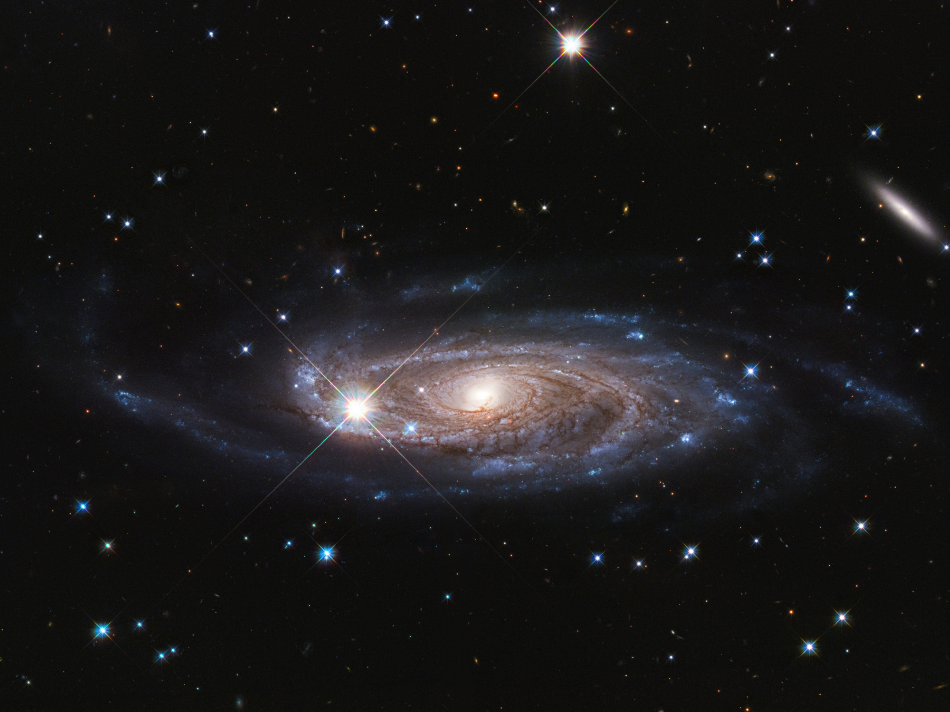Jan 7 2020
Astronomers have spotted UGC 2885, an incredible spiral galaxy that may be called the “Godzilla galaxy” since it may be the largest ever galaxy in the local universe. The width of the galaxy, which contains 10 times as many stars in the Milky Way, is also 2.5 times the size.
 This Hubble Space Telescope photograph showcases the majestic spiral galaxy UGC 2885, located 232 million light-years away in the northern constellation Perseus. The galaxy is 2.5 times wider than our Milky Way and contains 10 times as many stars. A number of foreground stars in our Milky Way can be seen in the image, identified by their diffraction spikes. The brightest star photobombs the galaxy’s disk. The galaxy has been nicknamed “Rubin’s galaxy,” after astronomer Vera Rubin (1928–2016), who studied the galaxy’s rotation rate in search of dark matter. Image Credit: NASA, ESA, and B. Holwerda (University of Louisville).
This Hubble Space Telescope photograph showcases the majestic spiral galaxy UGC 2885, located 232 million light-years away in the northern constellation Perseus. The galaxy is 2.5 times wider than our Milky Way and contains 10 times as many stars. A number of foreground stars in our Milky Way can be seen in the image, identified by their diffraction spikes. The brightest star photobombs the galaxy’s disk. The galaxy has been nicknamed “Rubin’s galaxy,” after astronomer Vera Rubin (1928–2016), who studied the galaxy’s rotation rate in search of dark matter. Image Credit: NASA, ESA, and B. Holwerda (University of Louisville).
However, according to researchers, it is a “gentle giant” since it appears to have been quiet over billions of years, perhaps absorbing hydrogen from the intergalactic space’s filamentary structure. This phenomenon fuels moderate progressive star birth at half the rate of the Milky Way.
The supermassive central black hole of the galaxy is also a sleeping giant. Since the galaxy does not seem to be devouring considerably smaller satellite galaxies, it is deprived of infalling gas.
Benne Holwerda from the University of Louisville, Kentucky, observed the galaxy using NASA’s Hubble Space Telescope and named it “Rubin’s galaxy,” after astronomer Vera Rubin (1928–2016).
My research was in a large part inspired by Vera Rubin’s work in 1980 on the size of this galaxy. We consider this a commemorative image. This goal to cite Dr. Rubin in our observation was very much part of our original Hubble proposal.
Benne Holwerda, Researcher, University of Louisville
Rubin measured the rotation of the galaxy, which offers evidence for the existence of dark matter which forms most of the galaxies mass, as quantified by the rotation rate.
In the findings being reported at the winter American Astronomical Society meeting in Honolulu, Hawaii, Holwerda has attempted to gain insights into the reasons behind the monstrous size of the galaxy.
How it got so big is something we don’t quite know yet. It’s as big as you can make a disk galaxy without hitting anything else in space.
Benne Holwerda, Researcher, University of Louisville
The fairly isolated occurrence of the galaxy in space is one hint for its appearance, as it has no neighboring galaxies to crash into and alter the shape of its disk.
Were considerably smaller satellite galaxies devoured by the monster galaxy over time? Or was gas just gradually accreted for forming new stars? “It seems like it’s been puttering along, slowly growing,” added Holwerda.
Holwerda and his colleagues leveraged Hubble’s remarkable resolution to count the number of globular star clusters in the galaxy’s halo, which is a hugr shell of faint stars surrounding the galaxy. A surplus of clusters would offer evidence that they were stolen from smaller infalling galaxies over several billions of years.
NASA’s forthcoming James Webb Space Telescope could be employed to investigate not just the center of this galaxy, but also the globular cluster population. NASA’s scheduled Wide Field Infrared Survey Telescope (WFIRST) would offer a much more comprehensive census of the cluster population of this galaxy, specifically that of the entire halo.
The infrared capability of both space telescopes would give us a more unimpeded view of the underlying stellar populations.
Benne Holwerda, Researcher, University of Louisville
This will be complementary to Hubble’s visible-light capability to detect wispy star formation through the entire galaxy.
In the image, several foreground stars in the Milky Way are visible, identified by their diffraction spikes. It seems the brightest star sits on top of the disk of the galaxy, although UGC 2885 is actually located 232 million light-years away. The giant galaxy is situated in the northern constellation Perseus.